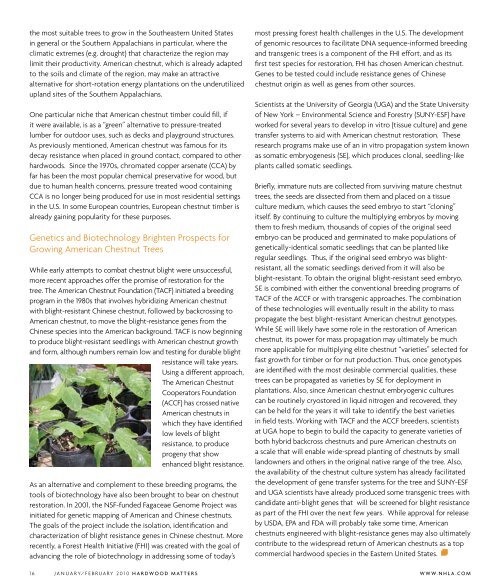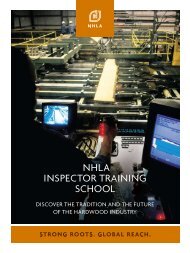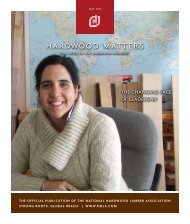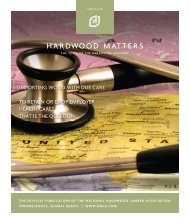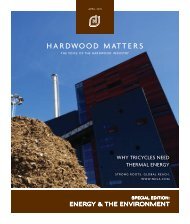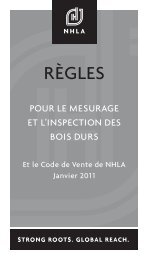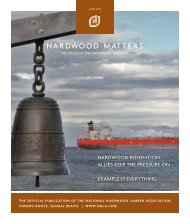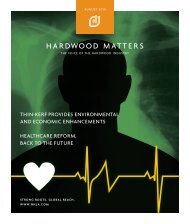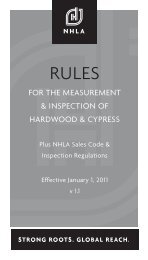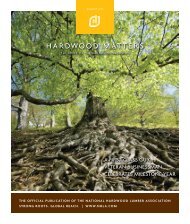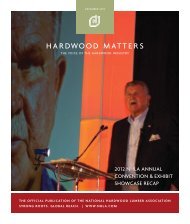Hardwood Matters - National Hardwood Lumber Association
Hardwood Matters - National Hardwood Lumber Association
Hardwood Matters - National Hardwood Lumber Association
You also want an ePaper? Increase the reach of your titles
YUMPU automatically turns print PDFs into web optimized ePapers that Google loves.
the most suitable trees to grow in the Southeastern United Statesin general or the Southern Appalachians in particular, where theclimatic extremes (e.g. drought) that characterize the region maylimit their productivity. American chestnut, which is already adaptedto the soils and climate of the region, may make an attractivealternative for short-rotation energy plantations on the underutilizedupland sites of the Southern Appalachians.One particular niche that American chestnut timber could fill, ifit were available, is as a “green” alternative to pressure-treatedlumber for outdoor uses, such as decks and playground structures.As previously mentioned, American chestnut was famous for itsdecay resistance when placed in ground contact, compared to otherhardwoods. Since the 1970s, chromated copper arsenate (CCA) byfar has been the most popular chemical preservative for wood, butdue to human health concerns, pressure treated wood containingCCA is no longer being produced for use in most residential settingsin the U.S. In some European countries, European chestnut timber isalready gaining popularity for these purposes.Genetics and Biotechnology Brighten Prospects forGrowing American Chestnut TreesWhile early attempts to combat chestnut blight were unsuccessful,more recent approaches offer the promise of restoration for thetree. The American Chestnut Foundation (TACF) initiated a breedingprogram in the 1980s that involves hybridizing American chestnutwith blight-resistant Chinese chestnut, followed by backcrossing toAmerican chestnut, to move the blight-resistance genes from theChinese species into the American background. TACF is now beginningto produce blight-resistant seedlings with American chestnut growthand form, although numbers remain low and testing for durable blightresistance will take years.Using a different approach,The American ChestnutCooperators Foundation(ACCF) has crossed nativeAmerican chestnuts inwhich they have identifiedlow levels of blightresistance, to produceprogeny that showenhanced blight resistance.As an alternative and complement to these breeding programs, thetools of biotechnology have also been brought to bear on chestnutrestoration. In 2001, the NSF-funded Fagaceae Genome Project wasinitiated for genetic mapping of American and Chinese chestnuts.The goals of the project include the isolation, identification andcharacterization of blight resistance genes in Chinese chestnut. Morerecently, a Forest Health Initiative (FHI) was created with the goal ofadvancing the role of biotechnology in addressing some of today’smost pressing forest health challenges in the U.S. The developmentof genomic resources to facilitate DNA sequence-informed breedingand transgenic trees is a component of the FHI effort, and as itsfirst test species for restoration, FHI has chosen American chestnut.Genes to be tested could include resistance genes of Chinesechestnut origin as well as genes from other sources.Scientists at the University of Georgia (UGA) and the State Universityof New York – Environmental Science and Forestry (SUNY-ESF) haveworked for several years to develop in vitro (tissue culture) and genetransfer systems to aid with American chestnut restoration. Theseresearch programs make use of an in vitro propagation system knownas somatic embryogenesis (SE), which produces clonal, seedling-likeplants called somatic seedlings.Briefly, immature nuts are collected from surviving mature chestnuttrees, the seeds are dissected from them and placed on a tissueculture medium, which causes the seed embryo to start “cloning”itself. By continuing to culture the multiplying embryos by movingthem to fresh medium, thousands of copies of the original seedembryo can be produced and germinated to make populations ofgenetically-identical somatic seedlings that can be planted likeregular seedlings. Thus, if the original seed embryo was blightresistant,all the somatic seedlings derived from it will also beblight-resistant. To obtain the original blight-resistant seed embryo,SE is combined with either the conventional breeding programs ofTACF of the ACCF or with transgenic approaches. The combinationof these technologies will eventually result in the ability to masspropagate the best blight-resistant American chestnut genotypes.While SE will likely have some role in the restoration of Americanchestnut, its power for mass propagation may ultimately be muchmore applicable for multiplying elite chestnut “varieties” selected forfast growth for timber or for nut production. Thus, once genotypesare identified with the most desirable commercial qualities, thesetrees can be propagated as varieties by SE for deployment inplantations. Also, since American chestnut embryogenic culturescan be routinely cryostored in liquid nitrogen and recovered, theycan be held for the years it will take to identify the best varietiesin field tests. Working with TACF and the ACCF breeders, scientistsat UGA hope to begin to build the capacity to generate varieties ofboth hybrid backcross chestnuts and pure American chestnuts ona scale that will enable wide-spread planting of chestnuts by smalllandowners and others in the original native range of the tree. Also,the availability of the chestnut culture system has already facilitatedthe development of gene transfer systems for the tree and SUNY-ESFand UGA scientists have already produced some transgenic trees withcandidate anti-blight genes that will be screened for blight resistanceas part of the FHI over the next few years. While approval for releaseby USDA, EPA and FDA will probably take some time, Americanchestnuts engineered with blight-resistance genes may also ultimatelycontribute to the widespread return of American chestnuts as a topcommercial hardwood species in the Eastern United States.16 JANUARY/FEBRUARY 2010 HARDWOOD MATTERS WWW.NHLA.COM


